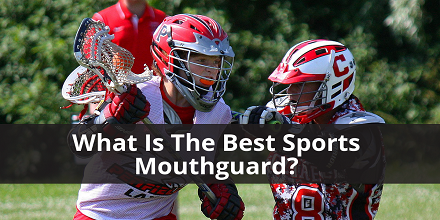
The Best Sports Mouthguard Is Custom-Fit By A Dentist
When it comes to choosing the best sports mouthguard to protect your smile, or your little athlete’s smile, choices abound.
Since April is National Facial Protection Month, let’s define the absolute best sports mouthguard once and for all.
Aside from a helmet – in some sports – a mouthguard could be considered the single most important piece of protective equipment.
Accidents happen, in fact, sports accidents reportedly account for 10 to 39 percent of all dental injuries in children.1
A 10 year study of 3,385 craniomaxillofacial trauma cases presenting to an oral and maxillofacial surgery department found 31.8 percent of injuries in children occurred during sports activities.2
Children are most susceptible to sports-related oral injury between the ages of seven and 11 years.3-6
But how do you choose the best one?
Let’s take a look at the three primary choices, and examine the pros & cons of each.
3 Types of Sports Mouthguards
1. Stock Mouthguards
Stock mouthguards are those rigid plastic off-the-shelf models that are ready to wear right out of the package. And they’re widely considered the absolute worst option for a sports mouthguard.
You can buy these at any sporting goods store, but why would you?
You can’t really do anything to adjust the fit, they’re incredibly uncomfortable, which makes talking – let alone breathing – extremely difficult.
Bottom line: stock mouthguards provide little or no protection, and dentists do not recommend them.
2. Boil & Bite Mouthguards
These are probably the most familiar to all of you that either have kids that play sports, or played youth sports yourself.
Boil & bite mouthguards can also can be purchased at any sporting goods store, and while debatable, they often do provide a better fit as compared to stock mouthguards.
Boil & bite mouthguards are made from similar plastic material, but are somewhat more malleable. The term “boil & bite” refers to how they are molded to the user’s teeth.
First, you place hold the mouthguard in a pot of hot water to soften, then you place it in the mouth and bite down to shape the mouthpiece around the teeth using suction, your fingers and your tongue.
Does that sound like a scientific approach to preventing broken teeth, chewed up gums, broken jaws, and expensive emergency dental treatment & oral surgery bills?
Bottom line: boil & bite mouthguards may be better than a stock piece of plastic, but they’re certainly not the best sports mouthguard out there.
3. Custom-Fit Mouthguards
Custom-fitted mouthguards are specifically designed for the individual, and they are made by a professional – in a dental office or a professional laboratory based on your dentist’s instructions.7
First, your dentist makes an impression of your teeth, then a mouthguard is molded over the model using a special material.
Due to the superior material, time, expertise, and work involved, custom-fit mouthguards are more expensive than the other types, but they provide the most comfort and the best protection.
Bottom line: Custom-fit are the best sports mouthguards because they are made by a dentist.
They are comfortable, resistant to tearing, durable, easy to clean, and do not restrict breathing or speech.
What Sports Require Mouthguards?
The American Dental Association recommends mouth guards for 29 sports.
These include everything from martial arts, to gymnastics, to equestrian events, to skateboarding. A good rule of thumb to remember is – when in doubt, use a mouthguard!
Better safe than sorry. An ounce of prevention is worth a pound of cure. And other such clichés.
Would you rather spend more money on a custom-fit mouthguard from your dentist, or LOTS more money on oral & maxillofacial surgery from the trauma resulting from a less than optimal choice of sports mouthguard?
Athletes participating in their chosen sports without the use of a mouthguard are 60 times more likely to incur an injury to the teeth.
Aside from protecting teeth, gums, cheeks & tongues from impact, the best sports mouthguards may also play a role in preventing and/or limiting damage from concussions.
Even if that is not a proven fact – yet – wouldn’t you be willing to gamble some extra money on a custom-fit mouthguard for your child athlete?
I’d bet dollars to donuts you would.
Should All Sports Require Mouthguards?
According to this policy developed by the Council on Clinical Affairs, in conjunction with the American Academy of Pediatric Dentistry:
“The administrators of youth, high school, and college football, lacrosse, and ice hockey have demonstrated that dental and facial injuries can be reduced significantly by introducing mandatory protective equipment.
Popular sports such as baseball, basketball, soccer, softball, wrestling, volleyball, and gymnastics lag far behind in injury protection for girls and boys.
Baseball and basketball have been shown to have the highest incidence of sports-related dental injuries in children seven to 17 years of age.6
More specifically, baseball had the highest incidence within the seven to 12-year-old age group, while basketball was the most frequent sport associated with dental injuries in the 13 to 17 year age group.6″
The Best Mouthguards for Sports…& Other Activities?
The AAPD study even goes on to mention how kids participating in leisure activities such as skateboarding, inline or roller skating, and bicycling – even trampolines – also benefit from using a mouthguard when participating in these sports or activities.3,8-10
“The use of the trampolines, when used recreationally, also contribute to a significant number of head and neck injuries occurs, with head injuries most commonly a result of falls.”
A large national survey confirmed the bicycle as the most common consumer sports product related to dental injuries in children.6
So, the need for a mouthguard isn’t necessarily limited to traditional sports like football, hockey, & lacrosse, but inline skating, skateboarding, and even riding a bicycle or backyard trampoline use.
Would your kid don a mouthguard to go ride a bike, or jump on the backyard trampoline?
How about those trampoline parks that seem to be popping up everywhere?
The Best Sports Mouthguard Is The One That Is Actually Worn!
Whether it’s taking a snap from under center, a roll dodge toward the crease, a one-timer from the top of the circle or jumping on the backyard trampoline, the best sports mouthguard is the one that is actually put to good use.
Sometimes kids complain that mouthguards are uncomfortable, or make it difficult to breathe – especially when out of breath in the first place – or make their mouth sore, or can’t speak clearly enough to communicate.
What usually happens then is the mouthguard dangles from the helmet, or makes its way into the pocket or waistband, making it totally useless.
Despite the best efforts of coaches, referees, umpires and school administrators, these instances occur.
If you’re an adult, so be it – you’re responsible for your own protection. And you’ll be the one footing the bill for the oral surgery.
But if you’re a parent, how can you make sure you’re protecting your athlete with the best mouthguard for their particular sport?
By getting a custom-fit mouthguard from your dentist.
The best sports mouthguards are custom-fit by a dentist because they offer the best protection and the most comfort.
This is why custom-fit mouthguards are widely considered the best option to protect orofacial injury.
Why Are Custom-Fit Mouthguards The Best For Any Sport?
For three primary reasons:
1. Custom-fit moutguards more comfortable.
2. Custom-fit moutguards don’t inhibit speech as much as stock or boil & bite mouthguards.
3. Custom-fit moutguards allow the user to breathe more freely than stock or boil & bite mouthguards.
Custom-fit mouthguards are specifically molded to the individual’s teeth, eliminating the discomfort from stock or boil & bite models, allow the person wearing it to speak clearly, and afford the user to breathe freely – particularly when they’re out of breath in the first place.
But it doesn’t matter if it’s custom-fit, boil & bite, or a stock mouthguard if it’s not being put to good use.
The best sports mouthguard is the one that is in your mouth!
Need A Dentist Near You To Custom-Fit A Sports Mouthguard? Find One Now
SOURCES:
1. Newsome P, Tran D, Cooke M. The role of the mouthguard
in the prevention of sports-related dental injuries:
A review. Int J Paediatr Dent 2001;11(6):396-404.
2. Gassner R, Tuli T, Hachl O, Moreira R, Ulmer H.
Craniomaxillofacial trauma in children: A review of 3,385
cases with 6,060 injuries in 10 years. J Oral Maxillofac
Surg 2004;62(4):399-407.
3. Tesini DA, Soporowski NJ. Epidemiology of orofacial
sports-related injuries. Dent Clin North Am 2000;44(1):
1-18.
4. Rodd HD, Chesham DJ. Sports-related oral injury and
mouthguard use among Sheffield school children. Community
Dent Health 1997;14(1):25-30.
5. American Dental Association Council on Access, Prevention,
and Interprofessional Relations and Council on
Scientific Affairs. Using mouthguards to reduce the incidence
and severity of sports-related oral injuries. J Am
Dent Assoc 2006;137(12):1712-20.
6. Stewart GB, Shields BJ, Fields S, Comstock RD, Smith
GA. Consumer products and activities associated with
dental injuries to children treated in United States emergency
departments 1990-2003. Dental Traumatol 2009;
25(4):399-405.
7. WebMD: https://www.webmd.com/oral-health/guide/mouth-guards#1
8. Ranalli DN. Prevention of sports-related dental traumatic
injuries. Dent Clin North Am 2000;44(1):35-51.
9. Finnoff JT, Laskowski ER, Altman KC, Diehl NW. Barriers
to bicycle helmet use. Pediatrics 2001;108(1):4-10.
10. Fasciglione D, Persic R, Pohl Y, Fillippi A. Dental injuries
in inline skating – Level of information and prevention.
Dent Traumatol 2007;23(3):143-8.


